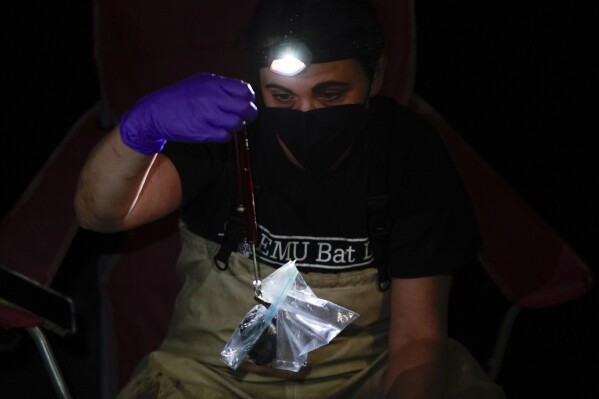After helping prevent extinctions for 50 years, the Endangered Species Act itself may be in peril

A bald eagle flies over a partially frozen Des Moines River, Dec. 21, 2022, in Des Moines, Iowa. Fifty years after the Endangered Species Act took effect, environmental advocates and scientists say the law is as essential as ever. Habitat loss, pollution, climate change and disease are putting an estimated 1 million species worldwide at risk.
A bald eagle flies over a partially frozen Des Moines River, Dec. 21, 2022, in Des Moines, Iowa. Fifty years after the Endangered Species Act took effect, environmental advocates and scientists say the law is as essential as ever. Habitat loss, pollution, climate change and disease are putting an estimated 1 million species worldwide at risk.
(AP Photo/Charlie Neibergall, File)
BY JOHN FLESHER
August 3, 2023
SHARON TOWNSHIP, Mich. (AP) — Biologist Ashley Wilson carefully disentangled a bat from netting above a tree-lined river and examined the wriggling, furry mammal in her headlamp’s glow. “Another big brown,” she said with a sigh.
It was a common type, one of many Wilson and colleagues had snagged on summer nights in the southern Michigan countryside. They were looking for increasingly scarce Indiana and northern long-eared bats, which historically migrated there for birthing season, sheltering behind peeling bark of dead trees.
The scientists had yet to spot either species this year as they embarked on a netting mission.
“It’s a bad suggestion if we do not catch one. It doesn’t look good,” said Allen Kurta, an Eastern Michigan University professor who has studied bats for more than 40 years.
The two bat varieties are designated as imperiled under the Endangered Species Act, the bedrock U.S. law intended to keep animal and plant types from dying out. Enacted in 1973 amid fear for iconic creatures such as the bald eagle, grizzly bear and gray wolf, it extends legal protection to 1,683 domestic species.
More than 99% of those listed as “endangered” — on the verge of extinction — or the less severe “threatened” have survived.
“The Endangered Species Act has been very successful,” Interior Secretary Deb Haaland said in an Associated Press interview. “And I believe very strongly that we’re in a better place for it.”
Biologist Ashley Wilson holds a big brown bat in Sharon Township, Mich., June 21, 2023. Fifty years after the Endangered Species Act took effect, environmental advocates and scientists say the law is as essential as ever. Habitat loss, pollution, climate change and disease are putting an estimated 1 million species worldwide at risk.
(AP Photo/Paul Sancya)Read More

2 of 4 |
Biologist Ashley Wilson weighs a captured big brown bat in Sharon Township, Mich., June 21, 2023. Fifty years after the Endangered Species Act took effect, environmental advocates and scientists say the law is as essential as ever. Habitat loss, pollution, climate change and disease are putting an estimated 1 million species worldwide at risk. (AP Photo/Paul Sancya)

2 of 4 |
Biologist Ashley Wilson weighs a captured big brown bat in Sharon Township, Mich., June 21, 2023. Fifty years after the Endangered Species Act took effect, environmental advocates and scientists say the law is as essential as ever. Habitat loss, pollution, climate change and disease are putting an estimated 1 million species worldwide at risk. (AP Photo/Paul Sancya)
A gray wolf is pictured on July 16, 2004, at the Wildlife Science Center in Forest Lake, Minn. Fifty years after the Endangered Species Act took effect, environmental advocates and scientists say the law is as essential as ever. Habitat loss, pollution, climate change and disease are putting an estimated 1 million species worldwide at risk.
(AP Photo/Dawn Villella, File)

A grizzly bear roams near Beaver Lake on July 6, 2011, in Yellowstone National Park, Wyo. Fifty years after the Endangered Species Act took effect, environmental advocates and scientists say the law is as essential as ever. Habitat loss, pollution, climate change and disease are putting an estimated 1 million species worldwide at risk.
A grizzly bear roams near Beaver Lake on July 6, 2011, in Yellowstone National Park, Wyo. Fifty years after the Endangered Species Act took effect, environmental advocates and scientists say the law is as essential as ever. Habitat loss, pollution, climate change and disease are putting an estimated 1 million species worldwide at risk.
(AP Photo/Jim Urquhart, File)
Fifty years after the law took effect, environmental advocates and scientists say it’s as essential as ever. Habitat loss, pollution, climate change and disease are putting an estimated 1 million species worldwide at risk.
Yet the law has become so controversial that Congress hasn’t updated it since 1992 — and some worry it won’t last another half-century.
Conservative administrations and lawmakers have stepped up efforts to weaken it, backed by landowner and industry groups that contend the act s tifles property rights and economic growth. Members of Congress try increasingly to overrule government experts on protecting individual species.
Fifty years after the law took effect, environmental advocates and scientists say it’s as essential as ever. Habitat loss, pollution, climate change and disease are putting an estimated 1 million species worldwide at risk.
Yet the law has become so controversial that Congress hasn’t updated it since 1992 — and some worry it won’t last another half-century.
Conservative administrations and lawmakers have stepped up efforts to weaken it, backed by landowner and industry groups that contend the act s tifles property rights and economic growth. Members of Congress try increasingly to overrule government experts on protecting individual species.
The act is “well-intentioned but entirely outdated ... twisted and morphed by radical litigants into a political firefight rather than an important piece of conservation law,” said Bruce Westerman, an Arkansas Republican and chairman of the House Committee on Natural Resources, who in July announced a group of GOP lawmakers would propose changes.
Environmentalists accuse regulators of slow-walking new listings to appease critics and say Congress provides too little funding to fulfill the act’s mission.
“Its biggest challenge is it’s starving,” said Jamie Rappaport Clark, president of the advocacy group Defenders of Wildlife.
After helping prevent extinctions for 50 years, the Endangered Species Act itself could be in peril
Fifty years after the U.S. Endangered Species Act took effect, officials say 99% of the animals and plants it protects have survived. But some scientists and activists fear the act itself is in trouble (Aug. 4)(AP video: Mike Householder)
Some experts say the law’s survival depends on rebuilding bipartisan support, no easy task in polarized times.
“The Endangered Species Act is our best tool to address biodiversity loss in the United States,” Senate Environment and Public Works chairman Tom Carper said during a May floor debate over whether the northern long-eared bat should keep its protection status granted in 2022.
“And we know that biodiversity is worth preserving for many reasons, whether it be to protect human health or because of a moral imperative to be good stewards of our one and only planet.”
Despite the Delaware Democrat’s plea, the Senate voted to nullify the bat’s endangered designation after opponents said disease, not economic development, was primarily responsible for the population decline.
That’s an ominous sign, said Kurta the Michigan scientist, donning waders to slosh across the mucky river bottom for the bat netting project in mid-June.
“Its population has dropped 90% in a very short period of time,” he said. “If that doesn’t make you go on the endangered species list, what’s going to?”
TURBULENT HISTORY
It’s “nothing short of astounding” how attitudes toward the law have changed, largely because few realized at first how far it would reach, said Holly Doremus, a University of California, Berkeley law professor.
Attention 50 years ago was riveted on iconic animals like the American alligator, Florida panther and California condor. Some had been pushed to the brink by habitat destruction or pollutants such as the pesticide DDT. People over-harvested other species or targeted them as nuisances.
California Condor named Hope takes to flight at the Los Angeles Zoo on Tuesday, May 2, 2023. (AP Photo/Richard Vogel)
FILE - A Florida panther, rescued as a kitten, was released back into the wild in the Florida Everglades, April 3, 2013. (AP Photo/J Pat Carter, File)
The 1973 measure made it illegal to “harass, harm, pursue, hunt, shoot, wound, kill, trap, capture or collect” listed animals and plants or ruin their habitats.
It ordered federal agencies not to authorize or fund actions likely to jeopardize their existence, although amendments later allowed permits for limited “take” — incidental killing — resulting from otherwise legal projects.
The act cleared Congress with what in hindsight appears stunning ease: unanimous Senate approval and a 390-12 House vote. President Richard Nixon, a Republican, signed it into law.
“It was not created by a bunch of hippies,” said Rebecca Hardin, a University of Michigan environmental anthropologist. “We had a sense as a country that we had done damage and we needed to heal.”
But backlash emerged as the statute spurred regulation of oil and gas development, logging, ranching and other industries. The endangered list grew to include little-known creatures — from the frosted flatwoods salamander to the tooth cave spider — and nearly 1,000 plants.
“It’s easy to get everybody to sign on with protecting whales and grizzly bears,” Doremus said. “But people didn’t anticipate that things they wouldn’t notice, or wouldn’t think beautiful, would need protection in ways that would block some economic activity.”
An early battle involved the snail darter, a tiny Southeastern fish that delayed construction of a Tennessee dam on a river then considered its only remaining home.
The northern spotted owl’s listing as threatened in 1990 sparked years of feuding between conservationists and the timber industry over management of Pacific Northwest forestland.
A northern spotted owl sits on a branch in Point Reyes, Calif., in June 1995. Fifty years after the Endangered Species Act took effect, environmental advocates and scientists say the law is as essential as ever. Habitat loss, pollution, climate change and disease are putting an estimated 1 million species worldwide at risk. (AP Photo/Tom Gallagher, File)
Rappaport Clark, who headed the U.S. Fish and Wildlife Service under President Bill Clinton, said there were still enough GOP moderates to help Democrats fend off sweeping changes sought by hardline congressional Republicans.
“Fast-forward to today, and support has declined pretty dramatically,” she said. “The atmosphere is incredibly partisan. A slim Democratic majority in the Senate is the difference between keeping the law on life support and blowing it up.”
The Trump administration ended blanket protection for animals newly deemed threatened. It let federal authorities consider economic costs of protecting species and disregard habitat impacts from climate change.
A federal judge blocked some of Trump’s moves. The Biden administration repealed or announced plans to rewrite others.
But with a couple of Democratic defections, the Senate voted narrowly this spring to undo protections for a rare grouse known as the lesser prairie chicken as well as the northern long-eared bat. The House did likewise in July.
President Joe Biden threatened vetoes. But to wildlife advocates, the votes illustrate the act’s vulnerability — if not to repeal, then to sapping its strength through legislative, agency or court actions.
One pending bill would prohibit additional listings expected to cause “significant” economic harm. Another would remove most gray wolves and grizzly bears — subjects of decades-old legal and political struggles — from the protected list and bar courts from returning them.
“Science is supposed to be the fundamental principle of managing endangered species,” said Mike Leahy, a senior director of the National Wildlife Federation. “It’s getting increasingly overruled by politics. This is every wildlife conservationist’s worst nightmare.”
ELUSIVE MIDDLE GROUND
Federal regulators are caught in a crossfire over how many species the act should protect and for how long — and how to balance that with interests of property owners and industry.
Since the law took effect, 64 of roughly 1,780 listed U.S. species have rebounded enough to be removed, while 64 have improved from endangered to threatened. Eleven have been declared extinct, a label proposed for 23 others, including the ivory-billed woodpecker.
That’s a poor showing, said Jonathan Wood, vice president of law and policy with the Property and Environment Research Center, which represents landowners.
The act was supposed to function like a hospital emergency room, providing lifesaving but short-term treatment, Wood said. Instead, it resembles perpetual hospice care for too many species.
But species typically need at least a half-century to recover and most haven’t been listed that long, said Noah Greenwald, endangered species director with the Center for Biological Diversity, an environmental group.
And they often languish a decade or more awaiting listing decisions, worsening their condition and prolonging their recovery, he said. The Fish and Wildlife Service has more than 300 under consideration.
The service “is not getting the job done,” Greenwald said. “Part is lack of funding but it’s mixed with timidity, fear of the backlash.”
Agency officials acknowledge struggling to keep up with listing proposals and strategies for restoring species. The work is complex; budgets are tight. Petitions and lawsuits abound. Congress provides millions to rescue popular animals such as Pacific salmon and steelhead trout while many species get a few thousand dollars annually.
To address the problem and mollify federal government critics, supporters of the act propose steering more conservation money to state and tribal programs. A bill to provide $1.4 billion annually cleared the House with bipartisan backing in 2022 but fell short in the Senate. Sponsors are trying again.
The Fish and Wildlife Service is using funds from Biden’s Inflation Reduction Act to improve strategies for getting species off the list sooner, Director Martha Williams told a House subcommittee in July.
It’s also seeking accommodation on another thorny issue: providing enough space where imperiled species can feed, shelter and reproduce.
The act empowers the government to identify “critical habitat” where economic development can be limited. Many early supporters believed public lands and waters — state and national parks and wildlife refuges — would meet the need, said Doremus, the California-Berkeley professor.
But now about two-thirds of listed species occupy private property. And many require permanent care. For example, removing the Kirtland’s warbler from the endangered list in 2019 was contingent on continued harvesting and replanting of Michigan jack pines where the tiny songbird nests.
Meeting the rising demand will require more deals with property owners instead of critical habitat designations, which lower property values and breed resentment, said Wood of the landowners group. Incentives could include paying owners or easing restrictions on timber cutting and other development as troubled species improve.
“You can’t police your way” to cooperation, he said.
The Fish and Wildlife Service proposed regulatory changes this year to encourage voluntary efforts, hoping they’ll keep more species healthy enough to reduce listings. But environmentalists insist voluntary action is no substitute for legally enforceable protections.
“Did the makers of DDT voluntarily stop making it? No,” said Greenwald, arguing few landowners or businesses will sacrifice profits to help the environment. “We have to have strong laws and regulations if we want to address the climate and extinction crises and leave a livable planet for future generations.
GRIM PROSPECTS
Stars and fireflies provided the only natural light on the June night after Michigan biologists Kurta and Wilson extended fine nylon mesh over smoothly flowing River Raisin, 90 minutes west of Detroit. Frogs croaked; crickets chirped. Mayflies — tasty morsels for bats — swarmed in the humid air.
Long feared by people, bats increasingly are valued for gobbling crop-destroying insects and pollinating fruit, giving U.S. agriculture a yearly $3 billion boost.
“The next time you have some tequila, thank the bat that pollinated the agave plant from which that tequila was made,” Kurta said, tinkering with an electronic device that detects bats as they swoop overhead.
Allen Kurta, an Eastern Michigan University professor, prepares netting to capture bats in Sharon Township, Mich., June 21, 2023. Fifty years after the Endangered Species Act took effect, environmental advocates and scientists say the law is as essential as ever. Habitat loss, pollution, climate change and disease are putting an estimated 1 million species worldwide at risk. (AP Photo/Paul Sancya)
Biologist Ashley Wilson prepares a net to capture bats in Sharon Township, Mich., June 21, 2023. Fifty years after the Endangered Species Act took effect, environmental advocates and scientists say the law is as essential as ever. Habitat loss, pollution, climate change and disease are putting an estimated 1 million species worldwide at risk. (AP Photo/Paul Sancya)
Hour after hour crept by. Eight bats fluttered into the nets. The scientists took measurements, then freed them. None were the endangered species they sought.
A month later, Kurta reported that 16 nights of netting at eight sites had yielded 177 bats — but just one Indiana and no northern long-eared specimens.
“Disappointing,” he said, “but expected.”
___
Associated Press climate and environmental coverage receives support from several private foundations. See more about AP’s climate initiative here. The AP is solely responsible for all content.
___
Follow John Flesher on Twitter at http://www.twitter.com@johnflesher

